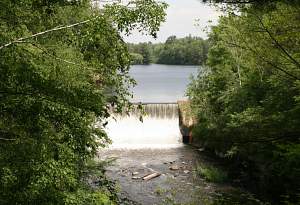Chippewa Falls Wisconsin



Edited by Lee C. Millard, 1950
The history of Chippewa Falls, according to various sources of historical data, dates back to the year 1836 when Jean Brunet built the first sawmill at the Falls and started a settlement. This mill was carried away by flood the following year, but was rebuilt in 1839, and the first permanent settlement was started in that year. The village of Chippewa Falls was platted in 1856, and this plat still appears on the records as the Original Plat of the City of Chippewa Falls. An act of the Legislature was passed in 1869 granting a charter, whereby the Village of Chippewa became the City of Chippewa Falls.
In the spring of 1870 occurred the first election under the new charter, at which time a Mayor, Treasurer, Assessor and six Aldermen were elected. Logging and lumbering appear to have been the main industry of the city up to 1911 when the big sawmill closed down. At one time Chippewa Falls operated the largest sawmill under one roof. In the early days the various sawmills operating along the Chippewa River and its tributaries sawed mostly White and Norway pine, and the logs were floated down the various streams to the Chippewa River, and at Chippewa Falls was operated the “Sorting Gap” where logs bearing the marks of various companies were sorted for the different mills operating further south along the river. The last few years the sawmill operated here, logs were hauled in by rail, and in that operation large quantities of Hemlock logs were hauled in to the mill.
During logging operations a large farming community was built up around the City, and after the sawmills closed down, a number of shoe factories were started to absorb labor, namely Chippewa Shoe Mfg. Co., Weyenberg Shoe Co., Hand Made Shoe Company, Hartman Shoe Company, Independent Shoe Company, and Mason Shoe Company. A large sugar beet factory was built and operated for a number of years. The Chippewa Falls Woolen Mill Company was started back in the lumbering days and is still in operation, larger than ever. The First National Bank was organized in 1873, The Lumbermens National Bank in 1887, and the Northwestern State Bank (successor of the Seymour Bank) in 1904. The first gas works was built in 1876 and the streets were lighted with gas. The electric light plant was authorized and built in 1886, but it was not until 1891 that the streets were lighted by electricity.
In 1897 franchise was granted for the laying of tracks and operation of electric street cars, to the Wisconsin-Minnesota Light and Power Company. Both local and interurban service (to Eau Claire) operated for about 30 years, when the car tracks were removed and bus service installed. In 1914 the Northern States Power succeeded the Wisconsin-Minnesota Power Company, and have taken over the water power on the Chippewa River, building dams and power houses at Chippewa Falls, Wissota, Jim Falls, Holcombe and operating Cornell under lease. Electric power from these installations serves the surrounding community, with lines reaching to Minneapolis and St. Paul. The Northern States Power Company serves the City with gas and electricity, furnishes the City with lighting in the form of White Way and overhead street lights. The operations of the Northern States Power Company as a public utility serving the city, pays to the city through the State around $50,000.00 in taxes each year. In 1920 the City purchased the existing waterworks system for $255,000.00 issuing 6% revenue bonds in payment thereof; in 1920 there were $120,000.00 in outstanding bonds which were called and refinanced at 2 ½%, and the last of these bonds were paid in May 1950, completely freeing the Water Department Utility of the City of debt. In addition, the Water Department has accumulated a sinking fund for expansion of about $35,000.00 and the total plant value and accounts is over $500,000.00.
.png)












